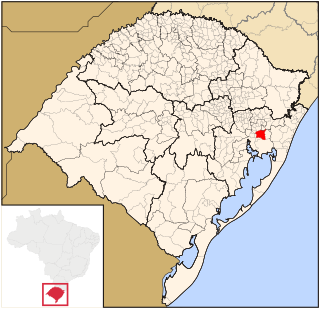
Rio de Janeiro, or simply Rio, is the second-most populous city in Brazil and the sixth-most populous in the Americas. Rio de Janeiro is the capital of the state of the same name, Brazil's third-most populous state, after São Paulo and Minas Gerais. Part of the city has been designated as a World Heritage Site, named "Rio de Janeiro: Carioca Landscapes between the Mountain and the Sea", on 1 July 2012 as a Cultural Landscape.

Rio de Janeiro is one of the 27 federative units of Brazil. It has the second largest economy of Brazil, with the largest being that of the state of São Paulo. The state, which has 8.2% of the Brazilian population, is responsible for 9.2% of the Brazilian GDP.
Botafogo is a beachfront neighborhood (bairro) in Rio de Janeiro, Brazil. It is a mostly upper middle class and small commerce community, and is located between the hills of Mundo Novo, Dona Marta and São João. The word Botafogo also refers to a Latin American ballroom dance move, named so because the area of Botafogo is where it originated.

Carl Friedrich Philipp von Martius was a German botanist and explorer.

Jacarezinho is a Brazilian neighborhood and also a favela with more than 60,300 residents living in an area of 40 ha. The place is located in the North Zone of Rio de Janeiro city, and it borders the neighborhoods of Jacaré, Méier, Engenho Novo and Triagem. It is the third largest favela in Rio de Janeiro, only behind Rocinha and Complexo do Alemão. The favela expanded along with the city's industrialization, and it became the biggest favela in Rio de Janeiro by the mid-20th century, with a population of 23,000 in 1960. The crucial element in its growth was the industrial boom in the nearby Méier district after World War II, according to historian by Julio César Pino, author of a book about the favelas of Rio de Janeiro.
Romanoa tamnoides is a species of plant of the family Euphorbiaceae. It is the sole species in the monotypic genus Romanoa, first described in 1824. It is native to Brazil and Paraguay.
Algernonia is a plant genus of the family Euphorbiaceae first described as a genus in 1858. It is native to Peru and Brazil.

Gravataí is a Brazilian municipality near Porto Alegre at the Rio Grande do Sul State. Its population is approximately 280,000 people, making it the sixth most populous city in the state.

José Mariano de Conceição Vellozo (1742–1811) was a Colonial Brazilian botanist who catalogued specimens, for example: Cedrela fissilis Vell. in Florae Fluminensis. He was born in Tiradentes, formerly called São José do Rio das Mortes, state of Minas Gerais; and died in Rio de Janeiro, state of Rio de Janeiro. While at the University of Coimbra in Portugal in the 1790s he worked with Martim Francisco Ribeiro de Andrada in translating works on mineralogy and agriculture. The standard author abbreviation Vell. is used to indicate this person as the author when citing a botanical name.
João Geraldo Kuhlmann was a Brazilian botanist.
The Federação de Futebol do Estado do Rio de Janeiro, usually known by the acronyms FERJ and FFERJ, manages all the official football tournaments within the state of Rio de Janeiro including the Campeonato Carioca, the Campeonato Carioca Série B1, the Copa Rio, and the Campeonato Carioca de Futebol Feminino. It was founded in 1978.

Santa Cruz is an extensive and populous neighborhood of the high class, lower middle and low in the West Zone of the municipality of Rio de Janeiro, Brazil, the farthest from the center of Rio de Janeiro. Cut by the Santa Cruz extension of the urban passenger rail network of the metropolitan region of Rio de Janeiro, it has a very diverse landscape, with commercial areas, residential and industrial.
Mangonia is a genus of flowering plants in the family Araceae. The genus contains only two known species native to southern Brazil and Uruguay.
- Mangonia tweedieanaSchott. - Rio Grande do Sul, Uruguay
- Mangonia uruguaya(Hicken) Bogner - Cerro Largo in Uruguay

Bixa is a genus of plants in the family Bixaceae. It is native to Mexico, Central America, Caribbean, and South America, and naturalized in other places.

Rauhiella is a genus of flowering plants from the orchid family, Orchidaceae.

Ipanema is a neighbourhood (bairro) in the city of Porto Alegre, the state capital of Rio Grande do Sul, in Brazil. It was created by Law 2022 from December 7, 1959.
Monochilus is a genus of plants in the mint family, Lamiaceae, first described in 1835. It contains two known species, both endemic to Brazil.
- Monochilus gloxinifoliusFisch. & C.A.Mey. - Rio de Janeiro
- Monochilus obovatusP.D.Cantino - Goiás

Siderasis is a genus of monocotyledonous flowering plants in the dayflower family, first described in 1837. It consists of a single known species, Siderasis fuscata, endemic to the State of Rio de Janeiro in southeastern Brazil, though it is also naturalized on the Island of Java in Indonesia.

Symphyotrichum martii is a species of flowering plant in the family Asteraceae endemic to Minas Gerais, Brazil. It is a perennial, herbaceous, hairless plant whose flowers have about 30 white ray florets.











